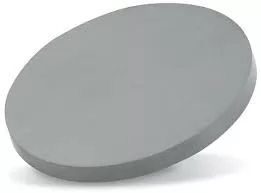What is a Silicon Carbide (SiC) Sputtering Target?
Silicon Carbide (SiC) Sputtering Target is a specialized material used in a process called sputtering, which is commonly employed in thin-film deposition for various industries including semiconductor manufacturing, optics, and electronics.
The sputtering target, in this case made of silicon carbide, is a solid material typically in the form of a disc or plate. During sputtering, energetic ions bombard the surface of the target, causing atoms or molecules to be ejected. These ejected particles deposit onto a substrate, forming a thin film.
Silicon carbide sputtering targets are specifically designed to produce thin films composed of silicon carbide, which is a compound of silicon and carbon. The properties of these thin films, such as optical transparency, electrical conductivity, and thermal stability, make them valuable for a wide range of applications, including semiconductor devices, optoelectronics, wear-resistant coatings, and high-temperature components.
Characteristics of Silicon Carbide (SiC) Sputtering Targets:
Now that we're familiar with Silicon Carbide (SiC) sputtering targets, let's explore their standout characteristics and why they deserve attention. Below are some key traits of SiC sputtering targets worth noting.
High purity metal sputtering target
Optical Transmittance:
SiC sputtering targets exhibit excellent optical transmittance, allowing a significant fraction of incident light to pass through them. This transparency makes them suitable for applications requiring optical clarity in thin-film coatings.
Piezoelectric Properties:
Silicon carbide sputtering targets possess piezoelectric properties, enabling them to accumulate electrical charges under mechanical stress. Additionally, they can generate internal mechanical strain in response to an electrical field, expanding their utility in sensor and actuator applications.
Bandgap:
SiC sputtering targets have a wide bandgap, typically ranging from 2.2 to 3.4 eV, depending on the polytype. This bandgap determines the material's electrical conductivity and makes it suitable for high-temperature and high-power electronic devices.
Electrical Conductivity:
Silicon carbide exhibits high electrical conductivity, making it a preferred choice for applications requiring efficient electrical conduction in thin films. This characteristic is crucial in electronic and semiconductor industries.
Thermal Stability:
SiC sputtering targets possess exceptional thermal stability, enabling their use in high-temperature environments without significant degradation. This stability ensures the reliability and longevity of coatings in various applications.
Utilization of Magnetron Sputtering Technology on SiC Sputtering Targets:
Magnetron sputtering, a widely employed thin-film deposition technique, utilizes SiC sputtering targets to produce high-quality coatings. Energetic ions bombard the SiC target, ejecting SiC particles that eventually deposit onto a substrate, forming thin films. The presence of a magnetic field near the target enhances the sputtering process, leading to precise and uniform film deposition.
Applications of SiC Sputtering Targets:
Semiconductor Devices:
SiC sputtering targets are crucial for manufacturing semiconductor devices, including diodes, transistors, and sensors. The material's excellent electrical properties and thermal stability make it ideal for high-power and high-frequency applications.
Optoelectronics:
Silicon carbide thin films deposited from sputtering targets find applications in optoelectronic devices such as LEDs, solar photovoltaics, and optical sensors. The material's optical transparency and electrical conductivity contribute to the performance of these devices.

Wear-resistant Coatings:
SiC coatings produced from sputtering targets are utilized in wear-resistant applications, including cutting tools, bearings, and mechanical seals. The material's hardness and durability enhance the longevity and performance of coated components.
High-temperature Applications:
Silicon carbide thin films deposited from sputtering targets are employed in high-temperature environments, such as aerospace components, furnace components, and thermal management systems, due to their exceptional thermal stability.
Conclusion:
Silicon carbide sputtering targets play a vital role in various industries, offering superior optical, electrical, and mechanical properties for thin-film coatings. Ongoing research aims to explore additional applications and further optimize the performance of SiC-based materials. For more information about sputtering targets, please visit [https://www.xk-sputteringtarget.com].



.png)

 +86-731-84027969
+86-731-84027969
 info@xk-sputteringtarget.com
info@xk-sputteringtarget.com




.png)

.png)
.png)
.png)
